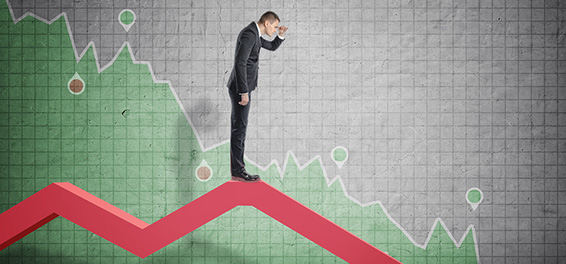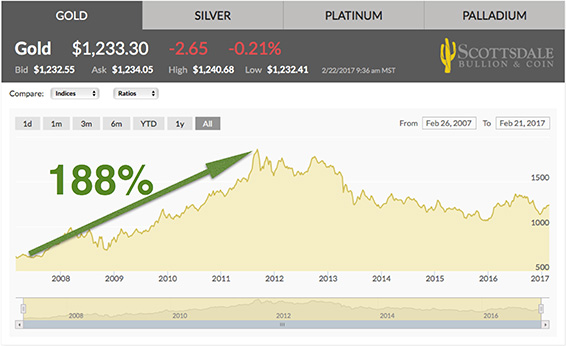S&P 500 Bubble Rising Dangerously Toward Collapse

Long bull runs historically lead to devastating economic fallout
Since Donald Trump became the 45th president of the United States of America, the S&P 500 has jumped more than 10%. What is behind this rapid growth in stocks? Dubbed by some as “Trump Hope,” it may be nothing more than a substantial group of investors with a misplaced sense of optimism, greed, or ignorance concerning the future of the American economy.
Considering the nation’s growing debt (currently around $20 trillion) combined with President Trump’s rhetoric of unbounded economic expansion, the skyrocketing stock market is cause for concern, at the very least, and a sign of impending collapse at the very worst.
“Those who cannot remember the past are condemned to repeat it.”
So said George Santayana, philosopher and writer (1863-1952). A quick surge in stocks does not reflect an economy grounded in reasonable economic growth; rather, it’s a red flag of a sharp reversal ahead. We’ve seen these historical moments before: a great boon before a great crash.
- President Coolidge’s era of excess in the 1920s led directly to the Great Depression.
- The dot-com boom in the 1990s opened up a decade of recession.
- The mortgage bubble burst us into the 21st century’s Great Recession.
Before every major recession was a long bull market, and we’re in one of the longest ones yet!
7 Longest Bull Markets in History
| Dates | Months | Percentage Gain | Subsequent Decline |
| 1990 – 2000 | 117 | 473% | -49% |
| 1921 – 1929 | 97 | 396% | -86% |
| March 09′ – Feb 17′ | 96 | 222% | ? |
| 1949 – 1956 | 70 | 249% | -22% |
| 1982 – 1987 | 60 | 201% | -34% |
| 2002 – 2007 | 60 | 105% | -57% |
| 1932 – 1937 | 56 | 266% | -60% |
| Average Bull Market Gain | Average Subsequent Bear Market Decline |
| ↑ 273% | ↓ -51% |
It might be weeks, or months or years—but there’s not a whole lot behind the country’s newfound economic optimism except a whole lot of hurt waiting to happen. Generally speaking, when the stock market is overvalued at the extreme levels we are seeing now, a sharp reversal occurs—the bubble bursts. The last time stocks were identified as being riskier than they are now was in 1929 and 1999.
Billionaires Make Large Bets Against the Stock Market

Warren Buffet Warns of Sharp Reversal Ahead
Billionaire Warren Buffett, one of the most successful investors in the world, is well regarded as a voice of reason in the financial world. He’s the third-wealthiest person alive, worth $60 billion, and he sure didn’t achieve that position by being wrong about his predictions. What he’s saying about 2017 could send chills down your spine: no matter how you cut it, an overvalued stock market foreshadows an eventual correction ahead.
Take a look at the chart below, which measures the market-cap-to-GDP of all U.S.-headquartered stocks traded on the major exchanges. Back in 2001, Buffett told Fortune magazine that “it is probably the best single measure of where valuations stand at any given moment.”

A reading of 100% shows stocks valued fairly; anything over that reflects stock market overvaluation. The index is at the third-highest point in the history of its existence—at 120%, much higher than the 45-year average, which stands around 75%.
Another financial indicator worth noting is called the 1.5% one-day decline, which signals an oncoming change in chart patterns, essentially a measure of normal variation. It’s been three months since the last 1.5% one-day decline—the longest period in the history of this metric, what analysts are calling “a sign of imminent danger.”
George Soros Invests Against the U.S. Market
Warren Buffett isn’t the only billionaire sending up warning signals. Billionaire George Soros recently hedged a $500 million dollar bet on the failure of the U.S. economy. According to Soros, companies that benefit from the policies of President Donald Trump will be “financially ruined” in the months ahead.
Trifecta of Greed, Arrogance & Unfounded Optimism at Work in the Markets
Buffett is famous for saying, “Be greedy when others are fearful and fearful when others are greedy.” Right now, American investors are pumped up on ‘America First’ rhetoric from the new administration, and no matter what your political position is, the economic indicators are very clear: the rampant investment in equities leads to an inflated stock market.
MarketWatch columnist Thomas H. Kee, Jr., observes:

“Of course, even with unique variables showing us that risk perceptions have absolutely increased, no one knows for sure what is going to happen, but we need to be responsible investors. Expecting the market to rise aggressively all the time is not something I believe is reasonable.
In fact, I would argue that the risk of a serious decline in stocks is real, given the magnitude of the increases and the relative valuations. So, given that risk perceptions have increased, it’s time to respect any warnings signs.”
He also notes “the sentiment that exists today borders on greed and arrogance.”
Financial researcher Michael T. Snyder of Seeking Alpha shares a similar view about the impetus of rising stocks recently:
“The U.S. stock market at this level reflects a combination of great demand, great complacency, and great greed. Stocks are clearly in a bubble, and like all bubbles, this one is about to burst.”
Knowledge Is Power: Avoid the Worst-Case Scenario

It’s possible that the reversal may not be catastrophic, but it’s looking fairly certain that some sort of drastic correction is bound to happen, and considering the economic picture, it’s probably not going to be pretty.
How far will the stock market correct?
How long will investors keep throwing bets into an equities market that is clearly inflated, on the rash hopes that what goes up must not come down?
How prepared is the American public for the crash at the end of the road?
Are you prepared for the eventual fallout?
Gold Rises as Stocks Fail

After the stock market plummeted in 2007-2008, the price of gold rose an astounding 188% to its highest-ever peak in 2011. If the looming crash is going to be as bad as some experts believe, investing in gold is both a protection against insecurity and also an investment in the potential for serious profits. A precious metal IRA is one of the best ways to invest in gold and capture long-term gains for a comfortable future.
Either way, diversity is a widely accepted measure of a healthy portfolio. Especially in times like these, when evidence points to a financial bubble about to burst, balancing your finances now is a wise investment move. Precious metals hold unequivocal value against failing paper systems.

